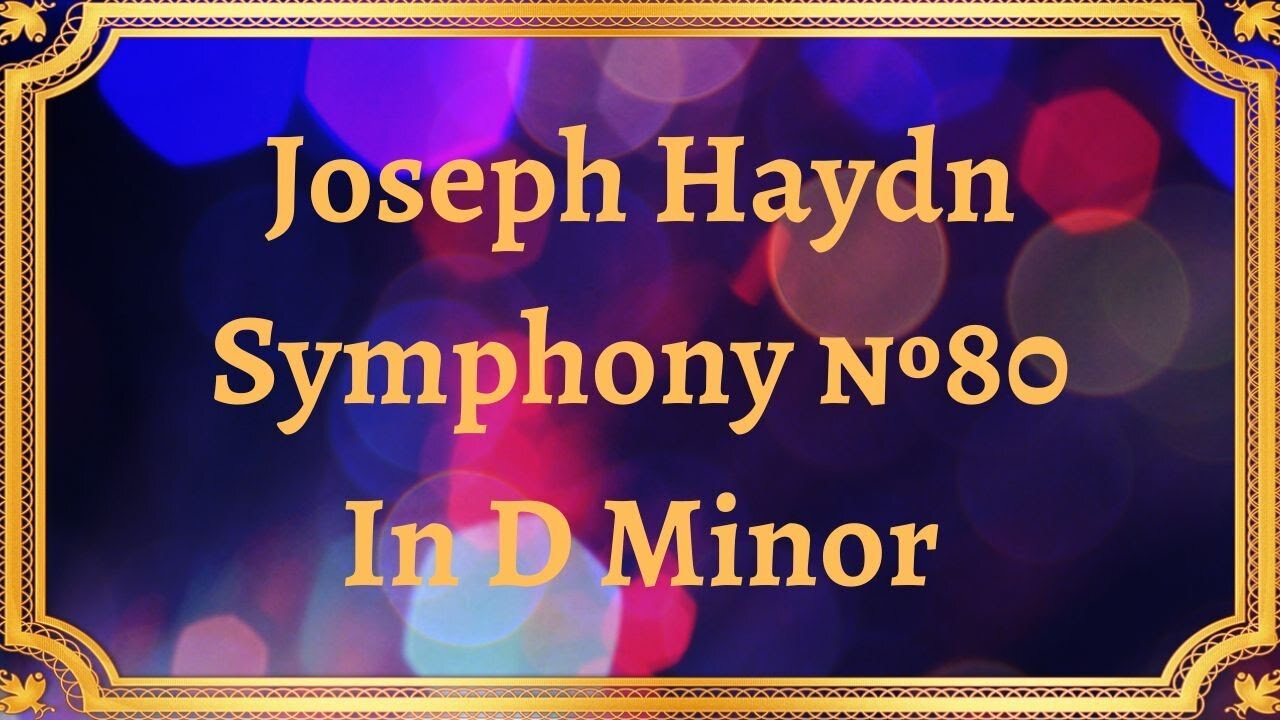Premium Only Content

Joseph Haydn Symphony №80 In D Minor
#JosephHaydn #SymphonyNo80 #DMinor #ClassicalMusic #MusicalComposition #HaydnSymphony #OrchestralMusic #MusicAppreciation #MusicHistory #Composer #Musician #ClassicalPeriod #MusicEnsemble #InstrumentalMusic #Symphony #ConcertMusic #MusicPerformance #MusicEducation #MusicScholarship
Publication date 1951
Wiener Symphoniker; Hermann Scherchen
Joseph Haydn, a pioneering figure in classical music, crafted a vast collection of symphonies that pushed the boundaries of the genre. Among his extraordinary works, Symphony No. 80 in D Minor stands out as a testament to Haydn's compositional genius and his ability to evoke profound emotions through his music.
Composed in the late 18th century, Symphony No. 80 in D Minor reflects Haydn's mastery during the classical period. This era witnessed a shift in musical style, with composers like Haydn breaking away from the strict conventions of the Baroque era. Haydn's symphonies played a significant role in shaping the classical style and paved the way for the monumental works of later composers.
Haydn's Symphony No. 80 follows the traditional four-movement structure commonly found in classical symphonies. The first movement, marked as an allegro spiritoso, sets the tone with its dramatic and intense opening. The second movement, an adagio, offers a contrasting lyrical and introspective atmosphere. The third movement, a minuet and trio, provides a moment of respite with its elegant and graceful melodies. Finally, the fourth movement, a presto, brings the symphony to a thrilling and triumphant conclusion.
Symphony No. 80 presents a rich tapestry of musical themes that intertwine and develop throughout the composition. Haydn expertly employs tonal and rhythmic variations to create tension and release, keeping the listener engaged and emotionally invested. The symphony's use of dynamic contrasts and unexpected harmonic shifts adds depth and complexity, intensifying the emotional impact of the piece.
Haydn's Symphony No. 80 takes listeners on an emotional journey, traversing a range of moods and sentiments. The first movement sets a somber and brooding atmosphere, filled with melancholic melodies and dramatic outbursts. The second movement offers solace and introspection, with its tender and lyrical melodies. The third movement injects a moment of elegance and grace, providing a temporary respite from the intensity. Finally, the fourth movement releases a surge of energy and triumph, leaving the listener invigorated and fulfilled.
Symphony No. 80 showcases Haydn's ability to convey profound emotions through music and has left a lasting impact on the classical music landscape. Its dramatic and expressive nature foreshadows the works of later composers, such as Beethoven. Haydn's innovative use of orchestration and thematic development in this symphony paved the way for future symphonic compositions, solidifying his status as a pioneer in the genre.
Conclusion:
Joseph Haydn's Symphony No. 80 in D Minor stands as a testament to his compositional brilliance and his ability to elicit deep emotions through music. Its meticulously crafted structure, thematic development, and evocative nature make it a masterpiece of the classical repertoire. As we immerse ourselves in the symphony's dramatic melodies and musical twists, we gain a deeper appreciation for Haydn's contributions to classical music. Symphony No. 80 serves as a timeless reminder of the power of music to move and inspire, leaving an indelible mark on the rich legacy of symphonic composition.
You have the opportunity to support the channel https://destream.net/live/RadSiarAl/donate
-
 6:07
6:07
Classical music_Music Inspiration
4 days agoJoseph Haydn Piano Sonata in D Major, Hob. XVI:51
331 -
 LIVE
LIVE
The Dana Show with Dana Loesch
24 minutes agoThe Dana Show | 01-29-25
302 watching -
 58:59
58:59
The Rubin Report
1 hour agoWatch Stephen Miller Destroy CNN Host’s Narrative with Facts in Only 2 Minutes
4.89K4 -
 LIVE
LIVE
Benny Johnson
3 hours ago🚨Robert F. Kennedy Jr. Confirmation LIVE Right NOW | Fauci and Big Pharma PANIC Over RFK!
20,855 watching -
 LIVE
LIVE
LFA TV
17 hours agoRFK CONFIRMATION & MORE! | LIVE FROM AMERICA 1.29.25 11am
6,766 watching -
 LIVE
LIVE
The Shannon Joy Show
1 hour ago🔥🔥Live Exclusive With Dr. Peter McCullough! RFK Jr. Confirmation Coverage & More!🔥🔥
294 watching -
 2:07:01
2:07:01
Steven Crowder
3 hours agoTrump’s Funding Freeze: Fact-Checking the Mainstream Media Lies
194K129 -
 DVR
DVR
Bannons War Room
1 year agoWarRoom Live
110M -
 43:59
43:59
MYLUNCHBREAK CHANNEL PAGE
2 hours agoWho REALLY Built Our Cities?
8.89K6 -
 38:25
38:25
Rethinking the Dollar
1 hour agoTrump Media Group Dives into Crypto with Truth.Fi Launch
5.47K1